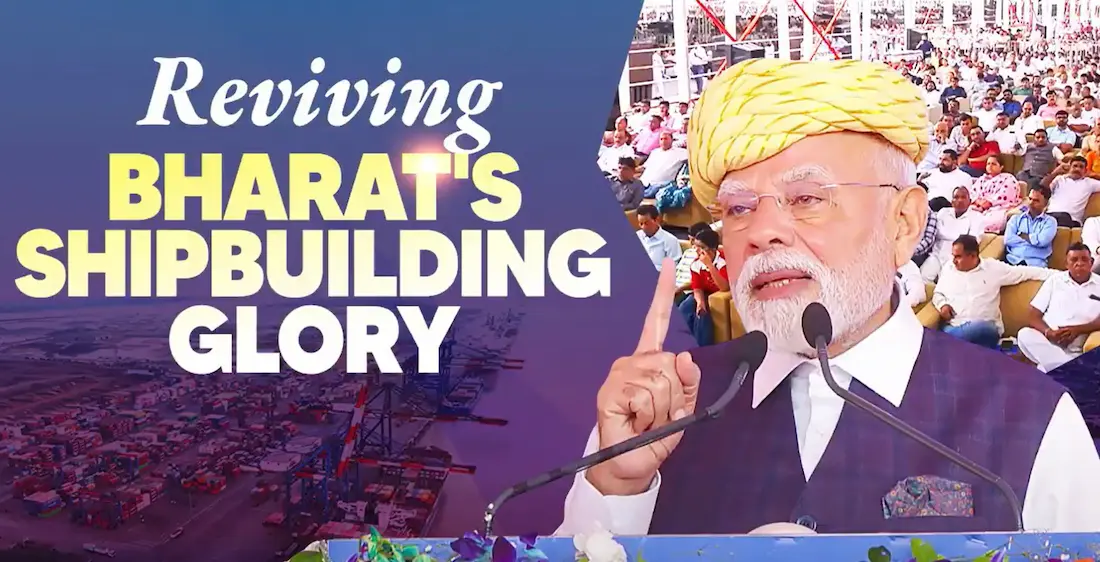
“Ships of Change”: Modi’s Rs 34,200 Crore Maritime Push Sets Sail for Self-Reliant India(photo-X@narendramodi)
Bhavnagar, Gujarat – September 20, 2025
Maritime Projects Could Transform India’s Economic Future – In a bold move to reshape India’s maritime future, Prime Minister Narendra Modi unveiled development projects worth ₹34,200 crore in Bhavnagar, Gujarat. The initiative, part of the “Samudra se Samriddhi” (Prosperity from the Sea) campaign, aims to reduce India’s dependence on foreign shipping and boost domestic manufacturing in shipbuilding, ports, and infrastructure.
From heartfelt moments with children to sweeping reforms in maritime policy, the event was more than a political showcase, it was a vision for India’s economic independence by 2047.
Why Maritime Self-Reliance Matters: The ₹6 Lakh Crore Problem
₹34,200 Crore Maritime Projects Could Transform India’s Economic Future – India currently spends a staggering ₹6 lakh crore every year on foreign shipping services. That’s nearly equal to the country’s defense budget. This heavy reliance on global shipping giants drains national resources and limits India’s control over its trade routes.
Modi’s speech in Bhavnagar struck a chord:
“India has no major enemy in the world, but our biggest adversary is dependence on others,” he said.
He emphasized that 50 years ago, 40% of India’s trade was carried on Indian-built ships. Today, that number has dropped to just 5%. The decline is not just economic—it’s symbolic of missed opportunities in industrial growth, job creation, and global competitiveness.
By investing in domestic shipbuilding and port infrastructure, India can reclaim its maritime legacy and create thousands of jobs across sectors like steel, electronics, textiles, and IT.
What’s in the ₹34,200 Crore Package: Ports, Ships, and Solar Power
The projects launched span across multiple sectors, but the maritime focus is clear. Here’s a breakdown of key developments:
| Project Name | Location | Sector | Highlights |
| Mumbai International Cruise Terminal | Indira Dock, Mumbai | Maritime Infrastructure | Boosts tourism and trade |
| Tuna Tekra Multi-Cargo Terminal | Gujarat | Ports | Enhances cargo handling capacity |
| Ship Repair Facilities | Patna & Varanasi | Shipbuilding | Supports inland waterway development |
| Green Bio-Methanol Plant | Deendayal Port, Kandla | Renewable Energy | Promotes clean fuel alternatives |
| HPLNG Regasification Terminal | Chhara Port | Energy Infrastructure | Strengthens LNG supply chain |
| Solarization of Dhordo Village | Kutch, Gujarat | Renewable Energy | Model for sustainable rural development |
| National Maritime Heritage Complex (NHMC) | Lothal | Tourism & Education | Celebrates India’s ancient maritime history |
These projects are expected to generate thousands of direct and indirect jobs, improve logistics efficiency, and attract global investment to India’s coastal regions.
Also read: Great Nicobar’s Big Leap: PM Modi Backs Island’s Transformation Plan
Reforms That Matter: Ships Now Classified as Infrastructure
One of the most significant announcements was the reclassification of large ship construction as “infrastructure.” This change will:
- Make shipbuilding eligible for easier financing
- Lower interest rates for shipyard investments
- Encourage private sector participation
- Boost India’s competitiveness in global shipping markets
Modi also launched three new schemes worth ₹70,000 crore to modernize shipyards, adopt advanced technologies, and upgrade design standards. These reforms are expected to create a ripple effect across industries and empower MSMEs.
“Chips or ships, we must make them in India,” Modi declared, reinforcing his push for domestic manufacturing.
The government also introduced “One Nation, One Document” and “One Nation, One Port Process” to simplify trade operations and eliminate colonial-era laws.
A Personal Touch: Modi’s Emotional Connect with Citizens
Beyond policy and infrastructure, the event had a deeply human side. Modi’s interactions with children, his roadshow through Bhavnagar, and his references to Navratri festivities added warmth to the occasion.
He acknowledged the cultural spirit of Gujarat and apologized for speaking in Hindi, showing sensitivity to local language preferences. Dance troupes performed along the roadshow route, and banners celebrated GST reforms and Operation Sindoor.
This blend of emotional engagement and strategic vision made the event resonate with citizens across age groups and regions.
Final Thoughts: Sailing Toward 2047 with Atmanirbharta
Modi’s maritime push is not just about ships and ports, it’s about reclaiming India’s place in the global economy. By investing in infrastructure, simplifying trade laws, and encouraging domestic manufacturing, India is charting a course toward self-reliance.
As the Prime Minister said, “Every rupee invested in shipbuilding will generate double the return.” With the right execution, these projects could transform India’s coastal regions into engines of growth and innovation.
The journey to 2047, India’s centenary of independence, is long. But with initiatives like these, the country is setting sail with confidence, purpose, and pride.
Stay informed with the latest news and updates – only on Rapido Updates.
1 thought on “Why Modi’s ₹34,200 Crore Maritime Projects Could Transform India’s Economic Future”
Comments are closed.